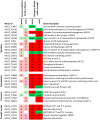No Time to Waste: Transcriptome Study Reveals that Drought Tolerance in Barley May Be Attributed to Stressed-Like Expression Patterns that Exist before the Occurrence of Stress
- PMID: 29375595
- PMCID: PMC5767312
- DOI: 10.3389/fpls.2017.02212
No Time to Waste: Transcriptome Study Reveals that Drought Tolerance in Barley May Be Attributed to Stressed-Like Expression Patterns that Exist before the Occurrence of Stress
Abstract
Plant survival in adverse environmental conditions requires a substantial change in the metabolism, which is reflected by the extensive transcriptome rebuilding upon the occurrence of the stress. Therefore, transcriptomic studies offer an insight into the mechanisms of plant stress responses. Here, we present the results of global gene expression profiling of roots and leaves of two barley genotypes with contrasting ability to cope with drought stress. Our analysis suggests that drought tolerance results from a certain level of transcription of stress-influenced genes that is present even before the onset of drought. Genes that predispose the plant to better drought survival play a role in the regulatory network of gene expression, including several transcription factors, translation regulators and structural components of ribosomes. An important group of genes is involved in signaling mechanisms, with significant contribution of hormone signaling pathways and an interplay between ABA, auxin, ethylene and brassinosteroid homeostasis. Signal transduction in a drought tolerant genotype may be more efficient through the expression of genes required for environmental sensing that are active already during normal water availability and are related to actin filaments and LIM domain proteins, which may function as osmotic biosensors. Better survival of drought may also be attributed to more effective processes of energy generation and more efficient chloroplasts biogenesis. Interestingly, our data suggest that several genes involved in a photosynthesis process are required for the establishment of effective drought response not only in leaves, but also in roots of barley. Thus, we propose a hypothesis that root plastids may turn into the anti-oxidative centers protecting root macromolecules from oxidative damage during drought stress. Specific genes and their potential role in building up a drought-tolerant barley phenotype is extensively discussed with special emphasis on processes that take place in barley roots. When possible, the interconnections between particular factors are emphasized to draw a broader picture of the molecular mechanisms of drought tolerance in barley.
Keywords: barley; drought tolerance; root system; stress; transcriptomics.
Figures







Similar articles
-
Insights into Barley Root Transcriptome under Mild Drought Stress with an Emphasis on Gene Expression Regulatory Mechanisms.Int J Mol Sci. 2019 Dec 5;20(24):6139. doi: 10.3390/ijms20246139. Int J Mol Sci. 2019. PMID: 31817496 Free PMC article.
-
Whole transcriptome analysis of transgenic barley with altered cytokinin homeostasis and increased tolerance to drought stress.N Biotechnol. 2016 Sep 25;33(5 Pt B):676-691. doi: 10.1016/j.nbt.2016.01.010. Epub 2016 Feb 11. N Biotechnol. 2016. PMID: 26877151
-
Physiological and molecular analysis on root growth associated with the tolerance to aluminum and drought individual and combined in Tibetan wild and cultivated barley.Planta. 2016 Apr;243(4):973-85. doi: 10.1007/s00425-015-2442-x. Epub 2016 Jan 9. Planta. 2016. PMID: 26748913
-
HvEXPB7, a novel β-expansin gene revealed by the root hair transcriptome of Tibetan wild barley, improves root hair growth under drought stress.J Exp Bot. 2015 Dec;66(22):7405-19. doi: 10.1093/jxb/erv436. Epub 2015 Sep 28. J Exp Bot. 2015. PMID: 26417018 Free PMC article.
-
Genome-Wide Identification and Characterization of Drought Stress Responsive microRNAs in Tibetan Wild Barley.Int J Mol Sci. 2020 Apr 17;21(8):2795. doi: 10.3390/ijms21082795. Int J Mol Sci. 2020. PMID: 32316632 Free PMC article.
Cited by
-
Methyl Jasmonate Affects Photosynthesis Efficiency, Expression of HvTIP Genes and Nitrogen Homeostasis in Barley.Int J Mol Sci. 2020 Jun 18;21(12):4335. doi: 10.3390/ijms21124335. Int J Mol Sci. 2020. PMID: 32570736 Free PMC article.
-
The BBX gene CmBBX22 negatively regulates drought stress tolerance in chrysanthemum.Hortic Res. 2022 Aug 25;9:uhac181. doi: 10.1093/hr/uhac181. eCollection 2022. Hortic Res. 2022. PMID: 36338842 Free PMC article.
-
EORNA, a barley gene and transcript abundance database.Sci Data. 2021 Mar 25;8(1):90. doi: 10.1038/s41597-021-00872-4. Sci Data. 2021. PMID: 33767193 Free PMC article.
-
Heat and drought induced transcriptomic changes in barley varieties with contrasting stress response phenotypes.Front Plant Sci. 2022 Dec 8;13:1066421. doi: 10.3389/fpls.2022.1066421. eCollection 2022. Front Plant Sci. 2022. PMID: 36570886 Free PMC article.
-
Genetic and Physiological Dissection of Photosynthesis in Barley Exposed to Drought Stress.Int J Mol Sci. 2019 Dec 16;20(24):6341. doi: 10.3390/ijms20246341. Int J Mol Sci. 2019. PMID: 31888211 Free PMC article.
References
-
- Aimar D., Calafat M., Andrade A. M., Carassay L., Abdala G. I., Molas M. L. (2011). Drought Tolerance and Stress Hormones: From Model Organisms to Forage Crops. Intech: From Model Organisms to Forage Crops. Available online at: https://www.intechopen.com/books/plants-and-environment/drought-toleranc...
LinkOut - more resources
Full Text Sources
Other Literature Sources
Molecular Biology Databases

